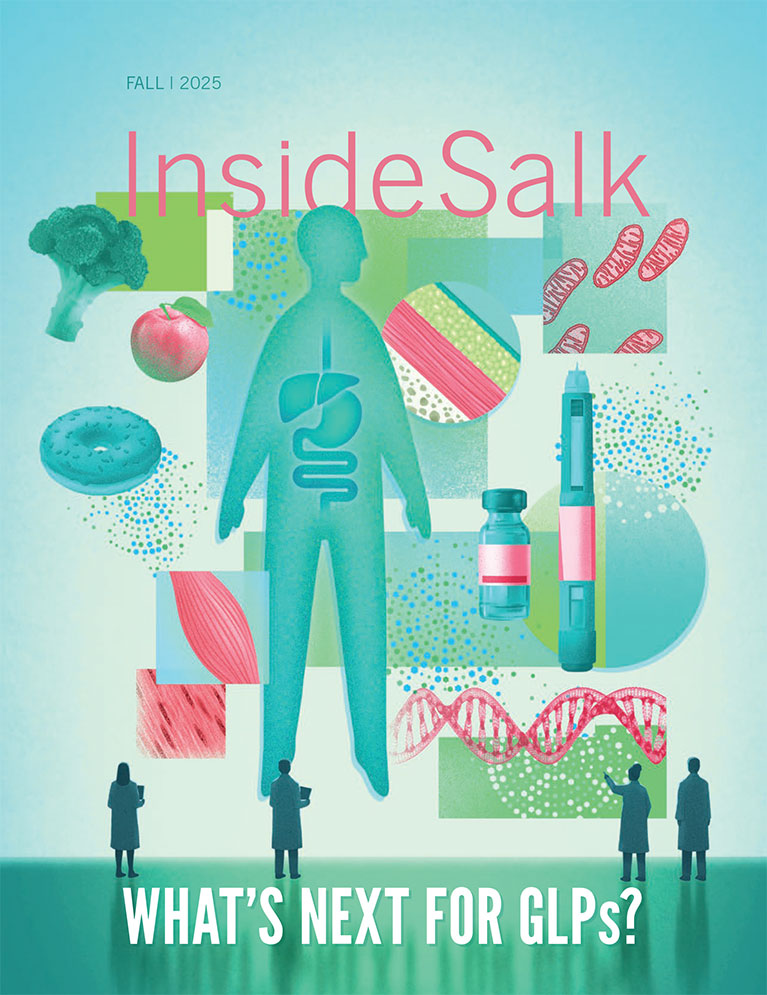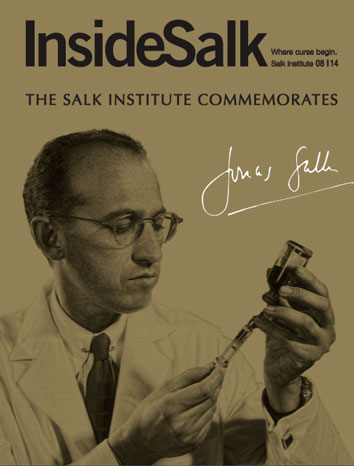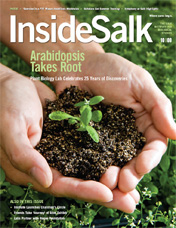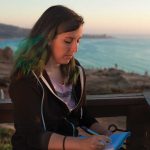Larry D. Greenfield has always been partial to contraptions. As a teen in Canoga Park, California, in the mid-to-late 1950s, he installed a closet door switch that would turn the closet light on and off when the door opened and closed. He also wired the whole backyard with lighting without any instructions—or his parents’ permission, but with the tacit blessing of his mother.
Today, the retired radiologist and his wife, Carol, who worked at Eastman Kodak and the Orange County Visitor and Convention Bureau, satisfy their mutual affinity for apparatus by supporting the equipment and technological needs of Salk’s scientists. The Carlsbad couple—who regularly attend Back to Basics lectures, Women & Science forums and Science & Music concerts—takes an especially keen interest in helping young researchers with labs to build.
“We like to give to things we can actually see,” says the couple.
One such techy gift was to Assistant Professor Nicola Allen, who studies cells in the brain called astrocytes. At a Salk reception, Allen mentioned to the couple that the Institute had only one cryostat, a machine that slices tissue very finely, and it was in high demand by multiple labs.
They did not like hearing that the researchers had to wait their turn to use the machine or that “one of Nicola’s postdocs was coming in at three in the morning just to have access to the machine,” says Carol.
“The Greenfields’ support of our science means a lot to my lab, both the interest they take in our work and the discoveries that we make, and their generous purchase of equipment that has allowed us to make scientific progress more rapidly,” says Allen, whose lab has grown from two to eight researchers since she joined Salk in 2013. Allen’s research has shown that astrocytes—star-shaped cells once thought to be “filler”—are crucial to brain function and they have significant potential for helping to understand neurodevelopmental and degenerative diseases like autism, schizophrenia, stroke and Alzheimer’s.
The new $40,000 cryostat the Greenfields purchased was a game changer for Allen’s research. The Greenfields have purchased other equipment for her lab, which they believe has been a boon to advancing her work.
The Greenfields say Allen has “blossomed into a tremendous researcher” in the short time they’ve been following her Salk career. It’s one of the reasons they favor giving to new scientists over more established investigators who have the support of grants and foundations, although supporting postdoctoral researchers among established Salk scientists is also part of their instrumental philanthropy.
Equipment is one of the costliest factors in biological science, and can quickly devour nearly half of a laboratory’s start-up budget, which conservative estimates place at about $1 million. Even with bargain hunting, new-faculty discounts or buying refurbished equipment, scientists shopping for big-ticket items such as centrifuges, tissue culture chambers and fluorescent stereo microscopes can expect price tags averaging $50,000 and soaring into hundreds of thousands of dollars.
In 2014, the Greenfields established the Larry D. Greenfield, MD and Carol A. Greenfield Technology Fund to help Salk scientists deal with these overwhelming costs. The couple believes funding for equipment often takes a back seat to other needs, such as salaries, but reasoned that biomedical breakthroughs can’t be made if scientists don’t have the right equipment. Besides one-time contributions, the technology fund matches gifts and creates challenges to fund expensive equipment.
Recently, the Greenfields’ fund gave $175,000 to augment $625,000 from the H. A. and Mary K. Chapman Charitable Trust enabling Salk to purchase mass spectrometry, genome sequencing and super resolution microscopy instruments.
“I don’t think people are aware of the important role that equipment plays in the advancement of science,” says Larry. “On the news, you hear the end result of the work but not the background, or that the scientists need a $40,000 microscope or a $40,000 tissue slicer, for example. It’s important for people to know science doesn’t happen automatically.”
When Assistant Professor Diana Hargreaves arrived at the Salk Cancer Center in 2014, the couple ensured that her lab was equipped with everything she needed to start her research. Hargreaves studies the cause and development of human tumors from a biochemical and epigenetic perspective.
It was the same kind of instrumental philanthropy they bestowed upon Sreekanth Chalasani when they underwrote the renovation of his first lab in 2014. Larry and Chalasani have maintained a pen pal-type correspondence ever since, one that runs heavy on the topic of zebrafish.
“The Greenfields have provided generous support for our zebrafish facility,” says Chalasani, associate professor in the Molecular Neurobiology Laboratory, who now studies the nervous system of roundworms to learn about human aggression and fear. “This has been critical to our research in understanding how the brain processes sensory information. Apart from their support, Larry is an enthusiastic advocate for our science. He is constantly pointing out new results and is very excited about the progress we make.”
Astrocytes and zebrafish aside, the Greenfields’ scientific interests include cancer (especially pancreatic and glioblastoma), dementia, and developing viable organs in animals for human organ transplant. Lately, they have taken a fancy to plant biology, too.
For example, the Greenfields’ generosity made it possible for Assistant Professor Julie Law to purchase a climate controlled plant growth chamber so she could investigate the connections between epigenetics, the environment and plant growth. In particular, Law focuses on characterizing several newly identified families of proteins involved with DNA packaging and gene expression, called chromatin binding proteins. Her studies will help expand current knowledge of epigenetic gene regulation and increase scientists’ ability to understand and control the expression of existing and newly introduced genes—research that has broad implications in both agriculture and gene therapy. “Connections with the San Diego community, such as with the Greenfields, is part of what makes Salk great,” says Law, who works in Salk’s Plant Molecular and Cellular Biology Laboratory and holds the Hearst Foundation Development Chair. “Their interest in the science, the people and the technologies that drive innovative discoveries energizes the research and provides new opportunities for scientific breakthroughs.”
Associate Professor Wolfgang Busch, also in Salk’s Plant Molecular and Cellular Biology Laboratory, is the latest Salk researcher to come under the Greenfields’ philanthropic radar. With Busch, the couple recently embarked on a whole new fundraising strategy for Salk—a crowdfunding campaign to raise $314,000 for a seed-planting robot that would enable Busch to study more efficiently the root growth responses of Arabidopsis thaliana to the environment. A better understanding of root systems could help scientists grow more resilient food sources, an increasingly urgent problem in the face of the planet’s shifting climate and extreme environments, such as drought.
“The Greenfields truly grasp how technology can change the way problems can be approached,” said Busch.
Throwing down the gauntlet, the Greenfields vowed to match the first $150,000 raised.
The return for the Greenfields’ gifts of funds, interest and energy is manyfold. Besides the satisfaction of boosting the start of several early career scientists, they like the accessibility and intellectual stimulation of talking to Salk’s researchers and touring their labs. They also delight in being patrons of the arts—while they don’t attend Symphony at Salk, they always purchase a table so research associates can enjoy the gala evening. This past summer, they hosted the 10 young women who were the recipients of the 2017 Salk Women & Science Special Awards Initiative.
The walls of the Greenfields’ La Costa Glen home are adorned with signed photographs of appreciative Salk scientists—and a picture of a glioblastoma cell culture from Research Associate Amy Rommel. The couple agrees with the metaphor of them being somewhat akin to fairy godparents to Salk’s early career scientists.
“We don’t have any kids,” the Greenfields say, so purchasing “the equipment is like having our own children.”























































